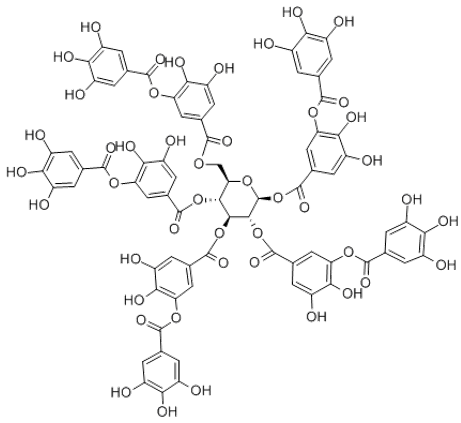Tannic acid is a polyphenolic compound with strong biological and pharmacological activities, a natural product with important exploitation value. v-innovate Technologies' high sensitivity and high resolution HPLC-mass spectrometry platform enables the identification and quantitative analysis of tannic acid.
Tannic acid is found in the bark and fruit of many trees, such as Chinese quince, Turkish quince, tara nut pods, pomegranate, lacquer leaves, yellow sedge, and witch hazel trees, and is also a major component of the insect fistula (galls) produced by insect infestation of these trees. Tannic acid is a typical glucose gallate compound and can be classified into three major groups according to their structural types: hydrolytic tannins, condensed tannins and complex tannins. The structure of polyphenolic hydroxyl groups gives it unique chemical properties and physiological activity.

Tannic acid is widely used in food, medicine, cosmetics, tanning, metallurgy, printing and dyeing, etc.
Tannic acid has astringent, antibacterial and anti-inflammatory, anthelmintic, anthelmintic, antidiarrheal and anti-infection effects of various pathogens, but also exhibits anti-tumor, anti-mutagenic, anti-lipid peroxidation and hypotensive, lipid-lowering, improving liver and kidney functions. Tannic acid binds the enzymes and toxic proteins of pathogens through the formation of hydrogen bonds between polyphenolic hydrocarbon groups and protein peptide carbonyl groups to inactivate them and then inhibit the enzymes' activities. It can also compound with metal ions to reduce the essential metal ions of microorganisms and affect the activity of metalloenzymes to produce anti-toxicity and achieve the effect of antibacterial and antiviral. The phenolic structure of tannic acid is an excellent hydrogen donor, which has a significant inhibitory effect on oxygen negative ions (-O2-) and hydroxyl radicals (-OH), and thus has a strong antioxidant effect. Tannins also inhibit the mutational stage of tumors and cancers, have multiple inhibitory activities against various mutagens, and promote damage repair of biological macromolecules and cells.
In the food industry, edible tannic acid can remove the cloudy precipitation caused by the presence of protein in beverages and liquors, so it is widely used as a clarifier and stabilizer. In leather production, tannic acid can combine with proteins in animal skin to form precipitates, making raw hides impermeable, dense and soft leather. In metallurgical industry, tannic acid can be hydrolyzed into 3,4,5-trihydroxybenzoic acid, which has large hydroxyl group and forms protective film on metal surface by ligand bonding, so it can be used in passivation treatment of zinc, copper, iron and their alloys to improve the quality of metal passivation.
The chemical structure and composition of tannic acid varies greatly from source to source. v-innovate Technologies can provide you with composition analysis, comparative analysis, qualitative and quantitative analysis and molecular weight analysis of tannins to accelerate your project.
Since different tissues have different matrix properties, v-innovate Technologies has developed multiple novel sample preparation techniques. Our services allow the profiling of more than 100 plant hormones, including tannins, tannic acid, cinnamtannins, cinnamtannin A1, cinnamtannin A2, etc.

Mode: MRM
Precision: pmol
Linear: R2 > 0.99
Analysis content:
We can detect for the following substances, including but not limited to:
| Tannic acid | Tannin matrine | Tannin ointment | Cinnamtannins |
| Cinnamtannin A1 | Cinnamtannin A2 | Apple tannic acid | Fruit tannins |
| The tea tannic acid | Coffee tannic acid | Persimmon tannin |
We can also accept other samples. Please contact us for the exact sample size required for detection.
In order to ensure the accuracy of the samples and reduce systematic errors during sampling, it is necessary to select more than 3 materials with the same condition for each sample. The same condition refers to the same period, basically the same phenotype, and the same part.
v-innovate Technologies is pleased to assist you with the identification and quantitative analysis of tannic acid to assist in your research. If you need to analyze other compounds, please contact us.
References
